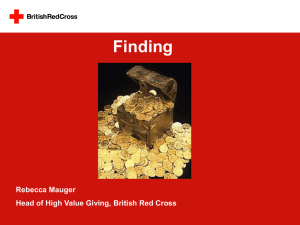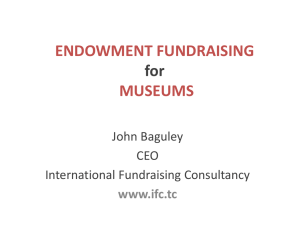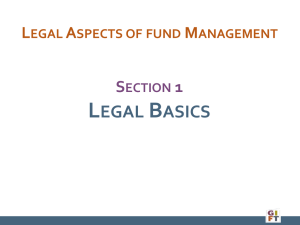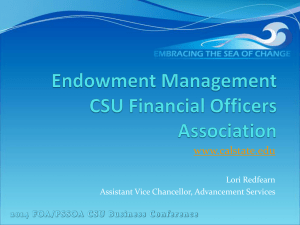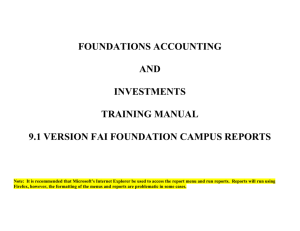View accompanying PowerPoint Presentation
advertisement
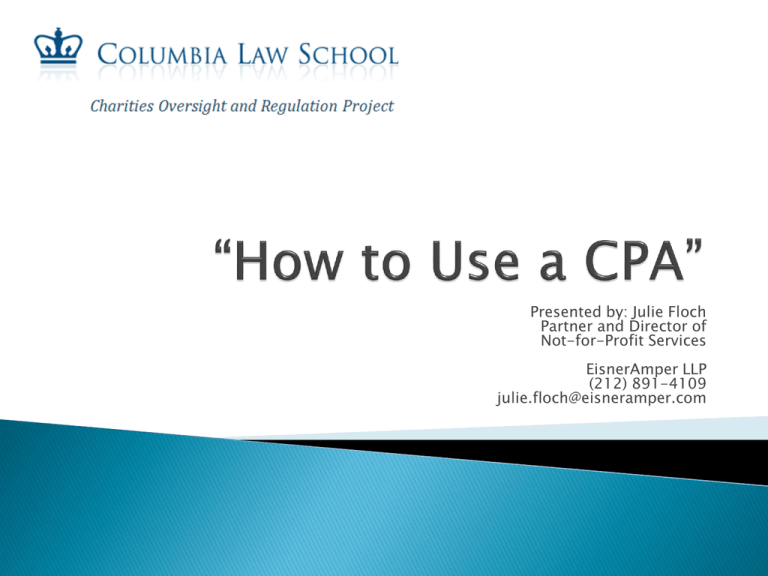
Presented by: Julie Floch Partner and Director of Not-for-Profit Services EisnerAmper LLP (212) 891-4109 julie.floch@eisneramper.com Accounting 101 Terms Non-Cash Donations Endowment Accounting GAAP vs Tax What Exactly is an Audit? Resources 2 AUTHORITATIVE GUIDANCE: Financial Accounting Standard Board (“FASB”) Generally Accepted Accounting Principles (“GAAP”) Accounting Standards Codification (“ASC”) International Accounting Standards Board (“IASB”) Generally Accepted Auditing Standards (“GAAS”) Public Company Accounting Oversight Board (“PCAOB”) Committee of Sponsoring Organizations (“COSO”) 4 NOT-FOR-PROFIT INDUSTRY TERMS: Contributions vs Exchange Transactions ◦ ◦ ◦ ◦ ◦ ◦ Unrestricted Temporarily restricted Permanently restricted Endowment UPMIFA vs UMIFA Board actions State distinctions Investment vs Endowment ◦ ◦ ◦ ◦ Restrictions Conditions Variance power Non-cash activities Governmental grants Deferred revenue Net Assets ◦ ◦ ◦ ◦ Unrealized gains & losses Realized gains & losses Dividend and interest income Release of restrictions ◦ ◦ ◦ Fair market value (“FMV”) Fair value hierarchy Net asset value (“NAV”) Investment income Programmatic Time Board appropriations Functional expenses ◦ ◦ Programmatic Ratios 5 December 31, 2011 2010 ASSETS Cash and cash equivalents Investments Pledges receivable, net Grants receivable Prepaid expenses and other current assets Inventory Property and equipment, net Security deposits $ 1,953,000 10,250,000 3,108,000 1,175,000 37,000 34,000 5,729,000 3,000 $ 22,289,000 $ 2,193,000 10,108,000 3,207,000 943,000 55,000 31,000 4,761,000 3,000 $ 21,301,000 6 December 31, 2011 2010 LIABILITIES Accounts payable and accrued expenses Deferred revenue Accrued vacation Annuities payable Accrued pension liability Bonds payable Total liabilities $ 671,000 301,000 231,000 150,000 650,000 3,700,000 5,703,000 $ 569,000 290,000 228,000 125,000 645,000 4,000,000 5,857,000 Commitments and contingency (Note M) 7 December 31, 2011 2010 Net assets: Unrestricted: Operating fund Board-designated fund 6,996,000 325,000 6,649,000 301,000 Total unrestricted 7,321,000 6,950,000 Temporarily restricted Permanently restricted 2,491,000 6,774,000 2,494,000 6,000,000 16,586,000 15,444,000 $ 22,289,000 $ 21,301,000 Total net assets 8 Year Ended Year Ended December 31, 2011 Unrestricted Operating support and revenue: Support: Government grants Contributions Direct mail campaigns Special events (net of direct benefit to donors of $280,000 and $145,000 in 2011 and 2010, respectively) Donated services and materials Total support Revenue: Catalog sales Change in value of split-interest agreements Investment income allocated for operations Other income Total revenue Support and revenue before net assets released from restrictions Net assets released from restrictions: Satisfaction of program and time restrictions Total support and revenue $ 2,519,000 2,853,000 1,293,000 Temporarily Restricted Permanently Restricted $ $ 774,000 1,295,000 688,000 8,648,000 Total $ 578,000 578,000 774,000 206,000 December 31, 2010 2,519,000 4,205,000 1,293,000 $ 2,685,000 3,483,000 1,462,000 1,295,000 688,000 843,000 814,000 10,000,000 9,287,000 206,000 124,000 30,000 55,000 101,000 25,000 30,000 80,000 101,000 15,000 50,000 103,000 392,000 25,000 417,000 292,000 9,040,000 603,000 10,417,000 9,579,000 0 0 10,417,000 9,579,000 626,000 (626,000) 9,666,000 (23,000) 774,000 774,000 9 Year Ended Year Ended December 31, 2011 Temporarily Permanently Restricted Restricted Unrestricted Expenses: Program services: Program 1 Program 2 Program 3 December 31, Total 2010 3,101,000 2,338,000 2,534,000 3,101,000 2,338,000 2,534,000 2,849,000 2,442,000 2,269,000 Total program services 7,973,000 7,973,000 7,560,000 Supporting services: Management and general Fund-raising 734,000 528,000 734,000 528,000 699,000 539,000 Total supporting services 1,262,000 1,262,000 1,238,000 Total operating expenses 9,235,000 9,235,000 8,798,000 1,182,000 781,000 50,000 21,000 (90,000) (200,000) Change in net assets from operations Change in net assets from nonoperating activities Investment results, net of allocation to operations Pension-related charges other than periodic costs (23,000) 30,000 20,000 774,000 (90,000) Change in net assets Net assets - beginning of the year Net assets - end of the year 431,000 371,000 6,950,000 $ 7,321,000 (3,000) 2,494,000 $ 2,491,000 $ 774,000 6,000,000 1,142,000 15,444,000 6,774,000 $ 16,586,000 602,000 14,842,000 $ 15,444,000 10 Program Services Program 1 Salaries Employee benefits and payroll taxes Donated materials Professional fundraising fees Professional fees (including Contributed services) Program supplies Occupancy Telephone Office expenses and supplies Equipment repair and maintenance Insurance Conferences and related costs Marketing and promotion Printing and publications Direct mail and other fund-raising Postage and shipping Depreciation expense Interest expense Miscellaneous $ Total expenses 832,000 Program 2 $ 742,000 Program 3 $ Year Ended December 31, 2011 Supporting Services Management and FundTotal General Raising 779,000 $ 2,353,000 $ 335,000 $ Total 164,000 $ 499,000 2011 $ 2,852,000 373,000 251,000 439,000 128,000 1,063,000 128,000 114,000 33,000 18,000 60,000 147,000 18,000 60,000 1,210,000 146,000 60,000 465,000 202,000 72,000 739,000 80,000 78,000 158,000 897,000 943,000 134,000 8,000 3,000 674,000 267,000 30,000 3,000 879,000 34,000 19,000 16,000 2,496,000 435,000 57,000 22,000 20,000 9,000 7,000 11,000 15,000 4,000 31,000 24,000 11,000 2,496,000 466,000 81,000 33,000 95,000 31,000 29,000 155,000 15,000 3,000 18,000 173,000 31,000 12,000 15,000 7,000 8,000 21,000 54,000 40,000 13,000 7,000 5,000 8,000 18,000 15,000 72,000 55,000 10,000 9,000 19,000 19,000 39,000 28,000 67,000 100,000 39,000 39,000 69,000 29,000 21,000 30,000 33,000 3,000 5,000 37,000 390,000 70,000 9,000 528,000 $1,262,000 19,000 33,000 33,000 11,000 30,000 1,000 183,000 1,000 114,000 5,000 60,000 7,000 357,000 2,000 1,000 1,000 4,000 $ 3,101,000 $ 2,338,000 $ 2,534,000 $ 7,973,000 1,000 12,000 70,000 2,000 $ 734,000 $ $ 9,235,000 11 THE IMPORTANCE OF A GIFT ACCEPTANCE AGREEMENT May outline the terms of a contribution so that the donor and charity agree on how the contribution will be used Have a clear understanding of the donor’s purpose and the charitable organization’s requirements Important to understand ultimate beneficiary of gift Common problem gifts: Ambiguous Gifts Overly Restrictive Gifts Naming Rights Gifts Large Gifts Hard to Value Gifts Split Interest Agreements 13 Art, Antiques and Collectibles Securities and Business Interests Split Interest Agreements Real Estate Life Insurance Medical Supplies Clothing 14 ART, ANTIQUES AND COLLECTIBLES FASB ASC 958-360-25-3 states that an NFP that holds works of art, historical treasures, and similar items that meet the definition of a collection has the following three alternative policies for reporting that collection: (a) capitalization of all collection items, (b) capitalization of all collection items on a prospective basis (that is, all items acquired after a stated date), or (c) no capitalization. Capitalization of selected collections or items is precluded. 15 SECURITIES AND BUSINESS INTERESTS Publicly Traded Securities May include stocks, bonds or mutual funds Great incentive to contribute rather than sell on the part of the donor • Avoid Federal and state income taxes on gain • But not securities held at a loss Recorded at FMV at the date of the gift C-Corporation Stock Deduction generally equal to fair market value of stock No tax on gain Charity will want an exit strategy Recorded at FMV at the date of the gift 16 SECURITIES AND BUSINESS INTERESTS S-Corporation Stock Ensure charity is permitted S Corp shareholder Alternative: Have S Corp gift assets to charity Recorded at FMV at the date of the gift (hard to value) LLC and Partnership Interests Deduction generally equal FMV less any ordinary income gain Charity subject to UBTI on trade or business income Recorded at FMV at the date of the gift 17 SPLIT INTEREST AGREEMENTS Charitable Remainder Trusts (CRT) Pays an annual stream of income to a non-charitable beneficiary for one life, two lives or a term of years Assets remain in the CRT at the end of the trust term and pass to charity Recorded at present value of the trust at the date of the gift (third party trustee) Record the present value of the assets at the date of the gift along with the present value of the annual income stream payable to the beneficiary (npo trustee) Charitable Gift Annuities (CGA) Donor may transfer assets to a charity and in return the charity will make the annuity payment to one or more individuals for their lifetimes Allows donor to retain income interests and deduct the fair market value for the contribution Record the FMV of the assets at the date of the gift and the present value of the annual income stream payable to the beneficiary 18 REAL ESTATE Gift of unencumbered real estate to public charity Charitable deduction equal to the fair market value of the real estate If private foundation, donor may deduct his or her basis Qualified appraisal required Recorded at FMV at the date of the gift Real estate encumbered by a mortgage Must reduce contribution deduction by the mortgage Unrelated Business Taxable Income (“UBTI”) • Debt-financed property will often result in UBTI (gross income from an unrelated trade or business) Recorded at FMV at the date of the gift less the amount of the mortgage 19 LIFE INSURANCE Must contribute the entire policy to receive maximum tax benefits No immediate income tax deduction for the mere payment of premiums for a policy with a charity named as beneficiary where the donor still maintains the ability to change the beneficiary Recorded at the estimated present value at the date of the gift In order to donate an existing life insurance policy to charity, you must assign all rights in the policy to the charity. You must also deliver the policy itself to the charity. By doing this, you give up all control of the life insurance policy forever. This strategy provides the full tax advantages of charitable giving because the transfer of ownership is irrevocable. You may be able to take an income tax deduction equal to your basis or its fair market value. The policy is not included in your gross estate when you die, unless you die within three years of the transfer. In this case, your estate would get an offsetting charitable deduction. 20 MEDICAL SUPPLIES The estimated fair value of the donations of medical supplies and equipment should be recorded at fair-value based upon the wholesale list value for new items and resale values listed by local and national dealers. The estimated fair value of these contributions is recorded in the financial statements as inventory and contribution revenue. As the medical supplies and equipment are distributed, program expenses are recorded. CLOTHING Thrift stores Goodwill Recorded at FMV at the date of the gift Could be poundage Could be by appraisal Hard to measure 21 WHAT IS AN ENDOWMENT? To a donor, an endowment is a sum of money given to a charity for charitable purposes, with only the “income” being spent and “principal” being preserved. To an accountant, it is a fund which is “permanently restricted”, or if board restricted then clearly labeled as such in unrestricted net assets. To a lawyer, it is an institutional fund not wholly expendable on a current basis under the terms of the gift instrument. Thus, a “true” endowment is one established or created by the donor. 23 WHAT IS THE ENDOWMENT BALANCE? A simple question that does not have a simple answer Each endowment has at least three answers to this question: The book value The market value The amount available for appropriation 24 THE BOOK VALUE Also referred to as corpus or principal Equal to the original gift amount Only changes if additional gifts are made, spending occurs from corpus (not income), or in some cases, if payout is re-invested Has important legal and accounting implications under Uniform Prudent Management of Institutional Funds Act (UPMIFA) 25 THE MARKET VALUE What the corpus is worth today Includes both the book (corpus) value and all accumulated income and/or losses Payout reduces the market value, not the corpus 26 AMOUNT AVAILABLE FOR APPROPRIATION Board of Trustees authorizes a payout rate annually for the following year Once distributed, the payout no longer participates in earnings, even if it is not spent 27 Donor directed/permanently restricted net assets Quasi endowment/board designated unrestricted net assets Uniform Management of Institutional Funds Act (“UMIFA”) Uniform Prudent Management of Institutional Funds Act (“UPMIFA”) 28 Donor directed/permanently restricted net assets The part of the net assets of a not-for-profit organization resulting (a) from contributions and other inflows of assets whose use by the organization is limited by donor imposed stipulations that neither expire by passage of time nor can be fulfilled or otherwise removed by actions of the organization, (b) from other asset enhancements and diminishments subject to the same kinds of stipulations, and (c) from reclassification from (or to) other classes of net assets as a consequence of donor imposed stipulations. Quasi endowment/Board designated net assets An action by a not-for-profit organization's board of directors to earmark an asset for a specified purpose. Since this is not a donor imposed restriction, the designated asset is classified and reported as part of unrestricted net assets. 29 Uniform Management of Institutional Funds Act (“UMIFA”) Is a uniform law which provides rules regarding how much of an endowment a charity can spend, for what purpose, and how the charity should invest the endowment funds. The drafters of UMIFA thought charities should be able to spend a prudent portion of the gains earned by an endowment. Uniform Prudent Management of Institutional Funds Act (“UPMIFA”) The most significant change made by UPMIFA is its elimination of the “historic dollar value” limitation on expenditures from endowment funds. Under UMIFA, while net appreciation could be spent, the “historic dollar value” of an endowment had to be preserved. Institutions are no longer limited in their ability to spend from “underwater” endowment funds (i.e., those with assets having current values less than when they were given). Under UPMIFA, an institution may spend as much as it deems “prudent” (subject to donor intent), depending on its particular state law. 30 Endowment net asset composition by type of fund December 31, 2011 Permanently Unrestricted Restricted Donor-restricted endowment funds Board-designated endowment funds $ 325,000 Total funds $ 325,000 Total $ 6,774,000 0 $ 6,774,000 325,000 $ 6,774,000 $ 7,099,000 Changes in endowment net assets December 31, 2011 Permanently Unrestricted Restricted Endowment net assets, beginning of year 301,000 $ 6,000,000 Investment return: Investment income Net depreciation (realized and unrealized) 19,000 (4,000) 0 19,000 (4,000) Total investment return 15,000 0 15,000 Contributions 14,000 774,000 788,000 Appropriation of endowment assets for expenditure (5,000) 0 (5,000) 325,000 $ 6,774,000 Endowment net assets, end of year $ $ $ Total $ 6,301,000 7,099,000 31 GAAP Donated services Unrealized gains and losses Variance power Special events revenue and expense Materiality Tax Investment expenses Entity level reporting vs consolidation Related party transactions 33 GAAP Treatment Tax Treatment Record gifts of property at fair market value Record gifts of property at fair market value Record gifts of use of facilities if otherwise needed to be paid Do NOT record use of facilities or gifts of donated services Recognize contributions of services if: Form 990 provides for a reconciliation to audited GAAP financial statements Create or enhance nonfinancial assets or Require specialized skills and would typically need to be purchased if not provided by donation Disclose in footnotes the extent of donated services even if not at a level that leads to recognition 34 GAAP Treatment Tax Treatment Show most investments at fair market value Unrealized gains and losses are not reported Investment expenses are generally netted against investment earnings Investment expenses are detailed on the schedule of functional expenses Form 990 provides for a reconciliation to audited GAAP financial statements 35 GAAP Treatment Tax Treatment Consolidated financial statements must be prepared if certain criteria are met Consolidated filings may not be filed, except under a group exemption Functional expenses not required for all organizations Functional expenses required for all 501 (c)(3) and (4) organizations Related party transactions are required to be disclosed for material items Related party transactions are required to be disclosed under various circumstances and thresholds on Schedules L and R Audit although not a matter of GAAP may be required by some states, funders and watchdog agencies Audit not required by IRS 36 The objective of an audit is for a professional auditor to evaluate or measure a subject matter that is the responsibility of another party against identified suitable criteria, and to express a conclusion (opinion) with a level of assurance about the subject matter for the intended user. 38 Kind of audit / assurance engagements A three party relationship The subject matter The scope of the audit Suitable criteria The audit process The report 39 The auditor has to observe: Integrity Objectivity Independence Professional competence and due care Confidentiality Professional behavior Application of technical standards The auditor should be: A member of a respected institute or organization with: • • • • quality control policies and procedures disciplinary rules a code of ethics auditing standards 40 Pre-audit Preliminary investigation Assignment process Performing the audit Initial investigation Evaluating and forming an opinion Completion Reporting Evaluating the audit 41 GAAS Internal Control Management letter Material weakness • A material weakness is a deficiency, or a combination of deficiencies, in internal control, such that there is a reasonable possibility that a material misstatement of the entity’s financial statements will not be prevented, or detected and corrected on a timely basis. Significant deficiency • A significant deficiency is a deficiency, or a combination of deficiencies, in internal control that is less severe than a material weakness, yet important enough to merit attention by those charged with governance. 42 American Institute of Certified Public Accountants (“AICPA”) Audit & Accounting Guide: Not-for-Profit Entities Audit Risk Alerts: Not-for-Profit Entities Industry Developments NPO Audit Committee Toolkit Financial Accounting Standards Board (“FASB”) FASB Codification Emerging Issues Task Force (“EITF”) 44 Watchdog Agencies Charity Navigator Better Business Bureau Wise Giving Alliance GuideStar 45
